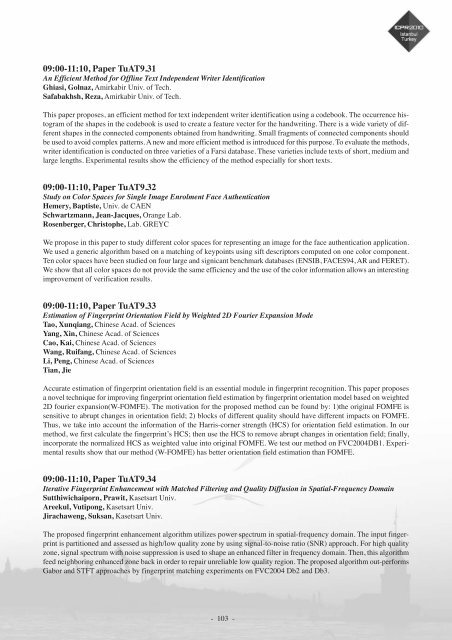Abstract book (pdf) - ICPR 2010
Abstract book (pdf) - ICPR 2010
Abstract book (pdf) - ICPR 2010
- TAGS
- abstract
- icpr
- icpr2010.org
You also want an ePaper? Increase the reach of your titles
YUMPU automatically turns print PDFs into web optimized ePapers that Google loves.
09:00-11:10, Paper TuAT9.31<br />
An Efficient Method for Offline Text Independent Writer Identification<br />
Ghiasi, Golnaz, Amirkabir Univ. of Tech.<br />
Safabakhsh, Reza, Amirkabir Univ. of Tech.<br />
This paper proposes, an efficient method for text independent writer identification using a code<strong>book</strong>. The occurrence histogram<br />
of the shapes in the code<strong>book</strong> is used to create a feature vector for the handwriting. There is a wide variety of different<br />
shapes in the connected components obtained from handwriting. Small fragments of connected components should<br />
be used to avoid complex patterns. A new and more efficient method is introduced for this purpose. To evaluate the methods,<br />
writer identification is conducted on three varieties of a Farsi database. These varieties include texts of short, medium and<br />
large lengths. Experimental results show the efficiency of the method especially for short texts.<br />
09:00-11:10, Paper TuAT9.32<br />
Study on Color Spaces for Single Image Enrolment Face Authentication<br />
Hemery, Baptiste, Univ. de CAEN<br />
Schwartzmann, Jean-Jacques, Orange Lab.<br />
Rosenberger, Christophe, Lab. GREYC<br />
We propose in this paper to study different color spaces for representing an image for the face authentication application.<br />
We used a generic algorithm based on a matching of keypoints using sift descriptors computed on one color component.<br />
Ten color spaces have been studied on four large and signicant benchmark databases (ENSIB, FACES94, AR and FERET).<br />
We show that all color spaces do not provide the same efficiency and the use of the color information allows an interesting<br />
improvement of verification results.<br />
09:00-11:10, Paper TuAT9.33<br />
Estimation of Fingerprint Orientation Field by Weighted 2D Fourier Expansion Mode<br />
Tao, Xunqiang, Chinese Acad. of Sciences<br />
Yang, Xin, Chinese Acad. of Sciences<br />
Cao, Kai, Chinese Acad. of Sciences<br />
Wang, Ruifang, Chinese Acad. of Sciences<br />
Li, Peng, Chinese Acad. of Sciences<br />
Tian, Jie<br />
Accurate estimation of fingerprint orientation field is an essential module in fingerprint recognition. This paper proposes<br />
a novel technique for improving fingerprint orientation field estimation by fingerprint orientation model based on weighted<br />
2D fourier expansion(W-FOMFE). The motivation for the proposed method can be found by: 1)the original FOMFE is<br />
sensitive to abrupt changes in orientation field; 2) blocks of different quality should have different impacts on FOMFE.<br />
Thus, we take into account the information of the Harris-corner strength (HCS) for orientation field estimation. In our<br />
method, we first calculate the fingerprint’s HCS; then use the HCS to remove abrupt changes in orientation field; finally,<br />
incorporate the normalized HCS as weighted value into original FOMFE. We test our method on FVC2004DB1. Experimental<br />
results show that our method (W-FOMFE) has better orientation field estimation than FOMFE.<br />
09:00-11:10, Paper TuAT9.34<br />
Iterative Fingerprint Enhancement with Matched Filtering and Quality Diffusion in Spatial-Frequency Domain<br />
Sutthiwichaiporn, Prawit, Kasetsart Univ.<br />
Areekul, Vutipong, Kasetsart Univ.<br />
Jirachaweng, Suksan, Kasetsart Univ.<br />
The proposed fingerprint enhancement algorithm utilizes power spectrum in spatial-frequency domain. The input fingerprint<br />
is partitioned and assessed as high/low quality zone by using signal-to-noise ratio (SNR) approach. For high quality<br />
zone, signal spectrum with noise suppression is used to shape an enhanced filter in frequency domain. Then, this algorithm<br />
feed neighboring enhanced zone back in order to repair unreliable low quality region. The proposed algorithm out-performs<br />
Gabor and STFT approaches by fingerprint matching experiments on FVC2004 Db2 and Db3.<br />
- 103 -



